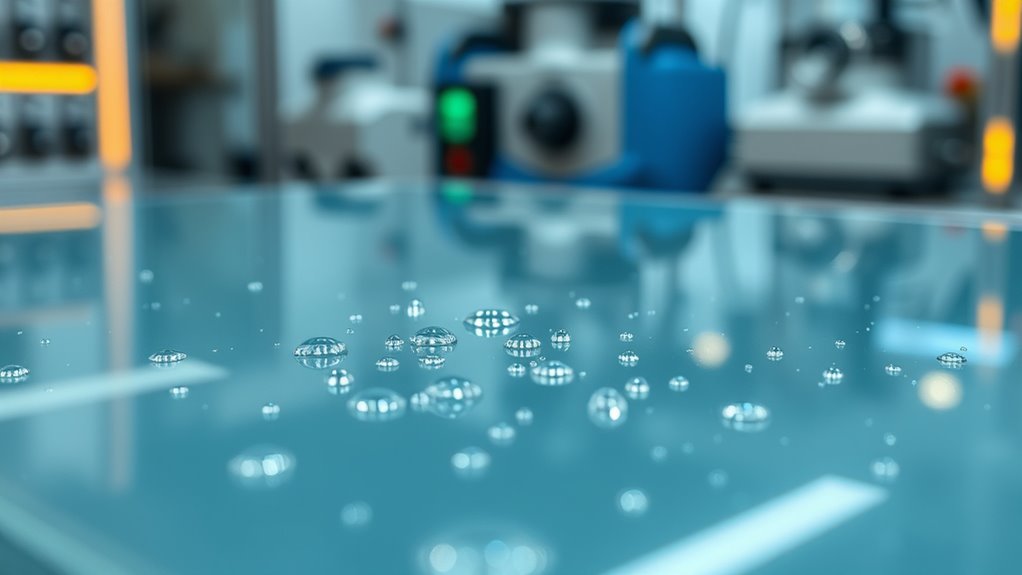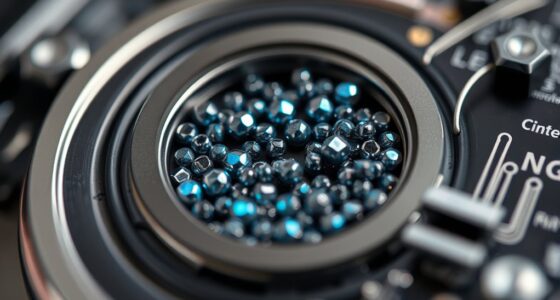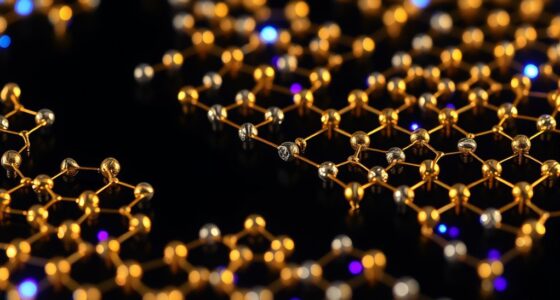Smart surfaces with nano-coatings transform ordinary materials into advanced, self-cleaning, and antimicrobial environments. These coatings make dirt, water, and microbes slide off or die, reducing your need for frequent cleaning and harsh chemicals. They also enhance durability, resisting wear and tear over time. Ideal for high-touch areas like door handles and countertops, these surfaces support hygiene and sustainability. If you want to explore how nano-coatings can improve your space, there’s more to discover.
Key Takeaways
- Nano-coatings create self-cleaning, water-repellent surfaces that resist dirt, dust, and water, reducing maintenance efforts.
- They provide antimicrobial protection by incorporating silver or copper nanoparticles, preventing microbial growth.
- Durable nano-coatings enhance surface longevity and wear resistance, maintaining functionality over time.
- Smart surfaces with nano-coatings are ideal for hygiene-critical environments like hospitals and kitchens, minimizing chemical use.
- These coatings contribute to sustainable maintenance by reducing cleaning frequency and chemical disinfectants.

Nano-coated smart surfaces are revolutionizing the way we interact with materials by offering dynamic, self-regulating properties. These advanced surfaces are designed to respond intelligently to environmental changes, providing practical benefits that enhance durability, hygiene, and convenience. One of the most remarkable features of nano-coated smart surfaces is their self-cleaning properties. When dirt, dust, or water droplets land on these surfaces, they often simply slide off or evaporate, thanks to their superhydrophobic nature. This means you spend less time scrubbing and cleaning, as grime doesn’t adhere stubbornly to the surface. Instead, contaminants are easily removed through minimal effort, maintaining a pristine appearance over time. This self-cleaning ability is especially useful in environments where hygiene is critical, such as hospitals, kitchens, or public spaces, reducing the need for harsh cleaning chemicals and frequent maintenance. Durability is another key aspect, as nano-coatings help surfaces withstand everyday wear and tear. In addition to their cleaning capabilities, these surfaces also boast antimicrobial effects. Nano-coatings can be infused with substances like silver or copper nanoparticles, which actively inhibit the growth of bacteria, fungi, and other microbes. As a result, your surfaces become less hospitable to germs, helping to prevent the spread of infections and illnesses. This antimicrobial property makes nano-coated smart surfaces highly valuable in healthcare settings, food processing plants, and even in everyday household items. You’ll appreciate how these surfaces contribute to a healthier environment without requiring constant disinfecting. The antimicrobial effects work continuously, providing ongoing protection even in high-touch areas such as door handles, countertops, and electronic devices.
Frequently Asked Questions
How Durable Are Nano-Coatings Under Extreme Environmental Conditions?
Nano-coatings are generally quite durable under extreme environmental conditions, thanks to their high abrasion resistance and thermal stability. You’ll notice they resist scratches and wear better than traditional coatings, even in harsh environments. They can withstand high temperatures and intense UV exposure, maintaining their protective properties. However, the durability depends on the specific formulation and application, so always consider the coating’s quality and intended use for best performance.
Are Nano-Coated Surfaces Environmentally Safe and Biodegradable?
Imagine a surface that stays clean and fresh without harming the environment. You’ll find that many nano-coatings raise biodegradability concerns, as some contain synthetic chemicals that don’t break down easily. However, eco-friendly alternatives are emerging, designed to be biodegradable and safe for nature. While these coatings can be environmentally safe, always verify labels and ingredients to guarantee they align with your sustainability goals.
Can Nano-Coatings Be Applied to Existing Surfaces or Only During Manufacturing?
You can apply nano-coatings to existing surfaces, not just during manufacturing. Their application versatility allows you to enhance various materials with proper surface preparation, ensuring ideal adhesion and performance. Whether you’re coating glass, metal, or plastic, you just need to clean and prepare the surface first. This flexibility makes nano-coatings ideal for retrofitting or upgrading existing surfaces, giving them new properties like water resistance, durability, and self-cleaning capabilities.
How Cost-Effective Are Nano-Coatings Compared to Traditional Surface Treatments?
Think of nano-coatings as a diamond in the rough—cost-effective over time. You’ll find that their initial application costs are higher than traditional treatments, but they often save money in the long run by reducing maintenance and extending surface life. When comparing costs, consider not just the application expenses but also the longevity and performance improvements they offer. Overall, nano-coatings tend to be a smarter investment for durability and efficiency.
What Are the Limitations of Nano-Coatings in Terms of Adhesion and Longevity?
You might face adhesion challenges with nano-coatings, especially on uneven or porous surfaces, which can cause the coating to peel or flake over time. Additionally, coating degradation due to environmental factors like UV exposure, moisture, or abrasion can shorten their longevity. To guarantee optimal performance, you need to take into account surface compatibility, proper application techniques, and protective measures to mitigate these limitations.
Conclusion
As you explore the domain of nano-coated smart surfaces, you realize their potential to revolutionize everyday life, much like how the printing press changed communication. These surfaces offer self-cleaning, durability, and adaptability that were once only imagined in science fiction. With ongoing advancements, you’ll find yourself in a future where surfaces think and respond, making your world smarter and more efficient. Embrace this cutting-edge technology—it’s like having your very own, modern-day magic wand.








